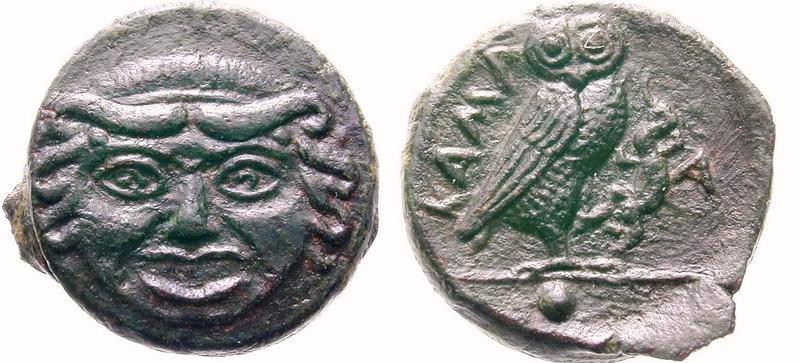Sicilian onkia
Dublin Core
Title
Sicilian onkia
Description
The city of Camarina, situated on the south coast of Sicily, had an eventful history. Founded in 598 BC by Syracuse, Camarina was deserted shortly afterward. Hippocrates, the tyrant of Gela, refounded the city in 492 BC. But again Camarina's destiny was not a fortunate one. Gelon I, Hippocrates' successor, moved the population to Syracuse after having transferred the government there; subsequently, Camarina became a ghost town. In 461 BC, the city was founded for the third time, yet was renounced again in 405 because of the Carthaginians' constant threat.
Despite these setbacks, Camarina's mint was important and productive. This coin, an onkia, was struck toward the end of the 5th century BC. Camarina's die-cutters were among the best and could easily be compared to the artists from the Syracusian mint.
The obverse depicts the gorgoneion, the chipped off head of Gorgo. In Sicilian iconography, Gorgo's head was considered to have strong magical power, because it's display fended off evil spirits. The gorgoneion was a frequent motif on coins, but also on temple and city walls, on weapons and on amulets. It can be seen on numerous Sicilian doors and houses until this day. The reverse depicts an owl holding a lizard in its claws. Underneath the animals is a pellet to indicate the coin's value of 1 onkia.
Despite these setbacks, Camarina's mint was important and productive. This coin, an onkia, was struck toward the end of the 5th century BC. Camarina's die-cutters were among the best and could easily be compared to the artists from the Syracusian mint.
The obverse depicts the gorgoneion, the chipped off head of Gorgo. In Sicilian iconography, Gorgo's head was considered to have strong magical power, because it's display fended off evil spirits. The gorgoneion was a frequent motif on coins, but also on temple and city walls, on weapons and on amulets. It can be seen on numerous Sicilian doors and houses until this day. The reverse depicts an owl holding a lizard in its claws. Underneath the animals is a pellet to indicate the coin's value of 1 onkia.
Publisher
Money Musuem, Sunflower Foundation
http://www.moneymuseum.com/moneymuseum/coins/search/coin3.jsp?i=2&t=onkia&pi=0&ps=10
http://www.moneymuseum.com/moneymuseum/coins/search/coin3.jsp?i=2&t=onkia&pi=0&ps=10
Date
410-405 BCE
Rights
® Sunflower Foundation
Collection
Citation
“Sicilian onkia,” Hallie Ford Museum of Art Exhibits, accessed December 19, 2025, https://library.willamette.edu/hfma/omeka/items/show/15.
